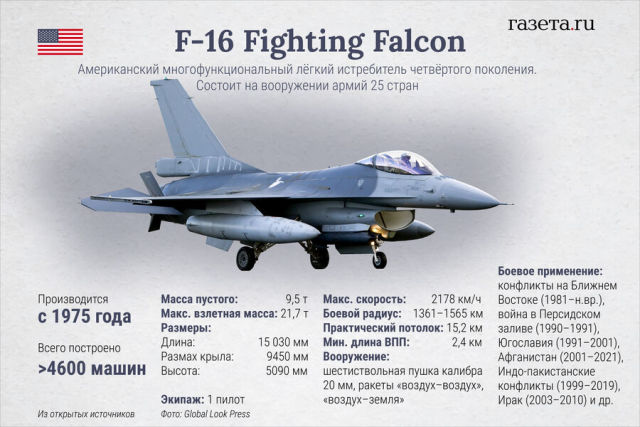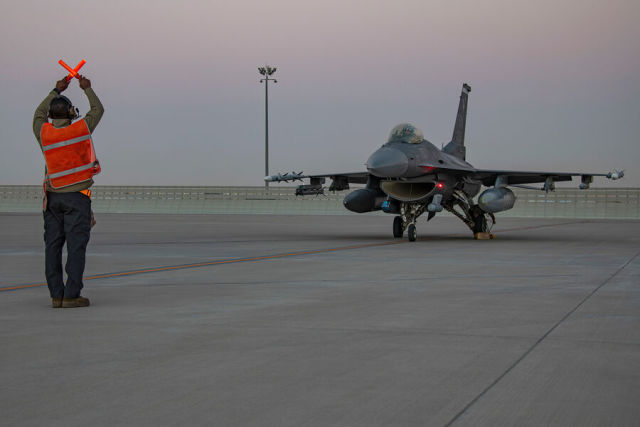And we are no longer talking about F-16 fighters in the service of the Armed Forces of Ukraine, but about gaining air superiority According to the authors of the British edition of The Spectator, Western countries are delaying the supply of modern fighters to the Ukrainian Air Forces due to the threat from Russian air defense systems - such a struggle requires the full power of the NATO air force, not single aircraft.
What is wrong with the conclusions of the authors of the article, the military observer of the "Newspaper.En" Mikhail Khodarenok.
What The Spectator writes about
Many in Europe and the United States are wondering why Western countries have not handed over to Ukrainian pilots for so long the formidable combat aircraft that the United States and its allies have used to have such a devastating effect on the enemy in any of the armed conflicts since the end of the Cold War, writes the British weekly conservative magazine The Spectator.
Western military experts believe that air superiority is a prerequisite for success on the battlefield, the publication reminds. And recent statements by the governments of the Netherlands and Poland have shown that they can transfer the F-16 Block 70/72 Viper multipurpose fighters to the APU. At the same time, senior leaders of the United States, Great Britain and Germany say that they will not do this yet. There are several probable reasons for such restraint, the author of the material believes.
First of all, the article says, this is the problem of echeloned and effective anti-aircraft missile cover for groups of troops and objects from the Russian Armed Forces, for the creation of which the long-range SA-21 Triumph (aka S-400), medium-range SA-17 Buk and short-range SA-15 are involved "Thor"
In addition, Russia is strengthening its capabilities to detect aerial objects with mobile solid-state three-coordinate radar stations with all-round radar type 48YA6-K1 "Approach".
The United States, reminds The Spectator, supplied the APU with a significant number of high-speed anti-radar missiles (PRR) AGM-88 (HARM), which were integrated into Ukrainian MiG-29 and Su-27 fighters of Soviet production. HARM-type PRRS (and similar Russian X-31P products, which are used in large numbers for strikes against Ukrainian air defense systems), are aimed at radar radiation sources.
Despite the fact that both sides launched quite a lot of anti-radar missiles during the fighting, not all of them achieved their goal - that is, a direct hit into the antenna devices of the SAM. In other words, HARM has not brought the elimination of threats from the Russian air defense system to Ukrainian aircraft closer, The Spectator believes.

Image source: Alina Jus/"Newspaper.Ru"
Any Western aircraft that can be delivered to Ukraine will face a serious threat from numerous Russian air defense systems, the British magazine is convinced. Even the comprehensive power of the united NATO air force would require a serious large-scale campaign to suppress and destroy the integrated air defense system of Russia, while combat aircraft would suffer considerable losses, the author believes.
Such suppression and destruction of the forces and means of the Russian air defense of the enemy will require hundreds of combat aircraft with very complex planning of operations and combat operations, appropriate aircraft weapons, tanker aircraft, long-range radar detection and control aircraft, complex ground infrastructure, as well as highly trained personnel.
The authors of the material believe that Western fighters supplied to the Ukrainian army in small numbers, such as the American F-16 Block 70/72 Viper (or F/A-18F Super Hornet, or Swedish Saab JAS 39 Gripen), will have to fly at extremely low and low altitudes, being dozens of kilometers from the front line, in order to reduce the range of their detection and tracking by Russian RTV radars and SAM/ZRS radars.
However, flights on MV and PMV will seriously reduce the effectiveness of combat aircraft in solving many key tasks. Direct air support of the troops requires that in this case the fighters fly at altitudes not lower than 6-7 thousand meters, that is, out of reach of small-caliber anti-aircraft artillery and MANPADS. Under these conditions, the maximum effectiveness of the use of almost all aviation weapons is achieved - from JDAM bombs to laser-guided missiles.
Such flights are not possible in the enemy's air defense zones, since fighters located at medium and high altitudes above the front line will be quickly hit by anti-aircraft guided missiles.
Thus, in this case, defeating enemy moving objects on the battlefield is an extremely difficult task.
There is reason to believe, writes The Spectator, that under such conditions, Ukrainian pilots are unlikely to be able to provide significant direct aviation support to their troops on the battlefields that will determine the course of the war this year, even if they receive Western fighters.
However, Western aircraft are needed to significantly increase the capabilities of Ukrainian pilots to combat Russian manned aircraft and cruise missiles, according to the publication. In this case, Western fighters could operate, as the Ukrainian MiG-29 and Su-27 are already doing, at medium and high altitudes in safer areas of Ukrainian airspace, far from the front line.
Since the Ukrainian anti-aircraft missile forces continue to suffer, albeit small, but steady losses and soon risk being completely left without Soviet and Russian-made anti-aircraft guided missiles, The Spectator writes, the provision of Western fighters to the AFU will become a critical factor preventing the Russian Aerospace Forces from launching new strikes against AFU groups and infrastructure facilities in Ukraine.
At the same time, Western fighters will not significantly affect ground battles in the coming months, The Spectator concludes.
What conclusions can be drawn
At first glance, the text of the British conservative magazine gives the impression of a very serious study. However, let's ask ourselves a question - what is not taken into account in the material? By and large, after all, we are talking about the conquest (retention) of air supremacy over Ukraine and to reduce this problem only to duels between Western-made aircraft and anti-aircraft missile systems would be fundamentally wrong.
To gain air supremacy, not only multifunctional fighters are involved, but also Ground Forces aviation, missile troops and artillery (RV and A), part of the fleet strike forces, reconnaissance forces and means, ground, air and sea electronic warfare.
Surprisingly, The Spectator did not mention a single word about electronic warfare, but without gaining superiority in the management of troops and weapons, any significant success in the conduct of modern armed struggle is simply impossible.
And here is just one example of the role of RV and A in combat operations. In particular, the small-diameter ground-launched bombs delivered by the APU will allow strikes on the launch positions of the SAM/SAMS at a distance of 150 km from the line of contact.
And the massive use of electronic warfare (Western-made fighters will be supplied with them) may just allow the AFU aircraft to operate at medium and high altitudes above the leading edge.
Finally, there is currently no dispute about the possibility/impossibility of supplying Western-made fighters to the Armed Forces of Ukraine. All decisions with a plus sign have been made for a long time, and the discussion in the media is conducted only for the general public.
Mikhail Khodarenok

